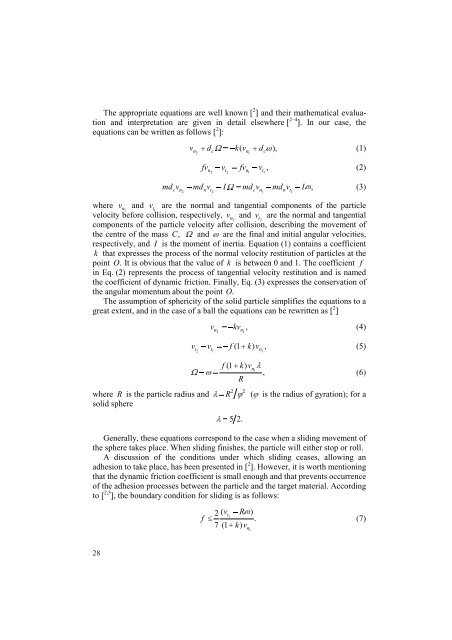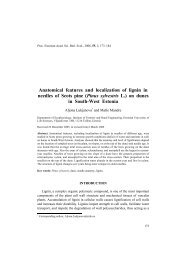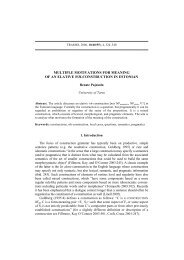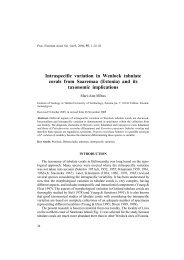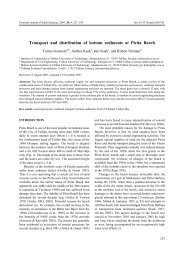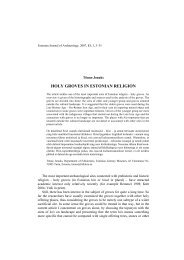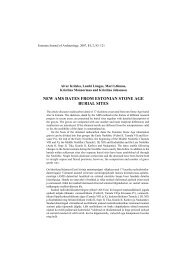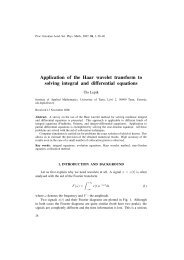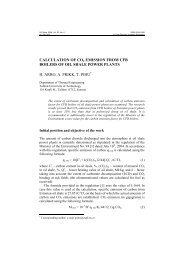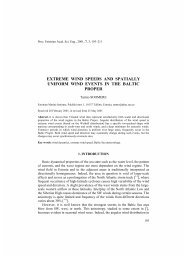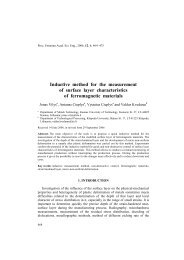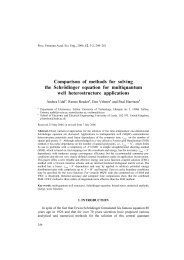Dynamic coefficients in impact mechanics
Dynamic coefficients in impact mechanics
Dynamic coefficients in impact mechanics
You also want an ePaper? Increase the reach of your titles
YUMPU automatically turns print PDFs into web optimized ePapers that Google loves.
The appropriate equations are well known [ 2 ] and their mathematical evaluation<br />
and <strong>in</strong>terpretation are given <strong>in</strong> detail elsewhere [ 2–4 ]. In our case, the<br />
equations can be written as follows [ 2 ]:<br />
+ =− + (1)<br />
v d k( v d ),<br />
n c n Ω<br />
ω c<br />
2 1<br />
− = − (2)<br />
fv v fv v<br />
n t n t<br />
2 2 1 1 ,<br />
− − = − − (3)<br />
md v md v I md v md v I ,<br />
c n n t c n n Ω<br />
t<br />
2 2 1 1<br />
where v n 1<br />
and v t 1<br />
are the normal and tangential components of the particle<br />
velocity before collision, respectively, v n 2<br />
and v t 2<br />
are the normal and tangential<br />
components of the particle velocity after collision, describ<strong>in</strong>g the movement of<br />
the centre of the mass Ω C ω , and are the f<strong>in</strong>al and <strong>in</strong>itial angular velocities,<br />
respectively, and I is the moment of <strong>in</strong>ertia. Equation (1) conta<strong>in</strong>s a coefficient<br />
k that expresses the process of the normal velocity restitution of particles at the<br />
po<strong>in</strong>t O . It is obvious that the value of k is between 0 and 1. The coefficient f<br />
<strong>in</strong> Eq. (2) represents the process of tangential velocity restitution and is named<br />
the coefficient of dynamic friction. F<strong>in</strong>ally, Eq. (3) expresses the conservation of<br />
the angular momentum about the po<strong>in</strong>t O .<br />
The assumption of sphericity of the solid particle simplifies the equations to a<br />
great extent, and <strong>in</strong> the case of a ball the equations can be rewritten as [ 2 ]<br />
v<br />
kv ,<br />
2 n1 n<br />
=− (4)<br />
ω<br />
− =− + (5)<br />
v v f(1 k) v ,<br />
Ω<br />
where R is the particle radius and<br />
solid sphere<br />
t t n<br />
2 1 1<br />
f(1 k)<br />
+ v n<br />
λ<br />
− =<br />
1<br />
,<br />
(6)<br />
ω<br />
R<br />
2 2<br />
λ ϕ = (ϕ R is the radius of gyration); for a<br />
λ = 52.<br />
Generally, these equations correspond to the case when a slid<strong>in</strong>g movement of<br />
the sphere takes place. When slid<strong>in</strong>g f<strong>in</strong>ishes, the particle will either stop or roll.<br />
A discussion of the conditions under which slid<strong>in</strong>g ceases, allow<strong>in</strong>g an<br />
adhesion to take place, has been presented <strong>in</strong> [ 2 ]. However, it is worth mention<strong>in</strong>g<br />
that the dynamic friction coefficient is small enough and that prevents occurrence<br />
of the adhesion processes between the particle and the target material. Accord<strong>in</strong>g<br />
to [ 2,5 ], the boundary condition for slid<strong>in</strong>g is as follows:<br />
f<br />
2 ( vt<br />
R ) ω −<br />
1<br />
≤<br />
.<br />
+ 7(1 k)<br />
v<br />
n1<br />
(7)<br />
28


